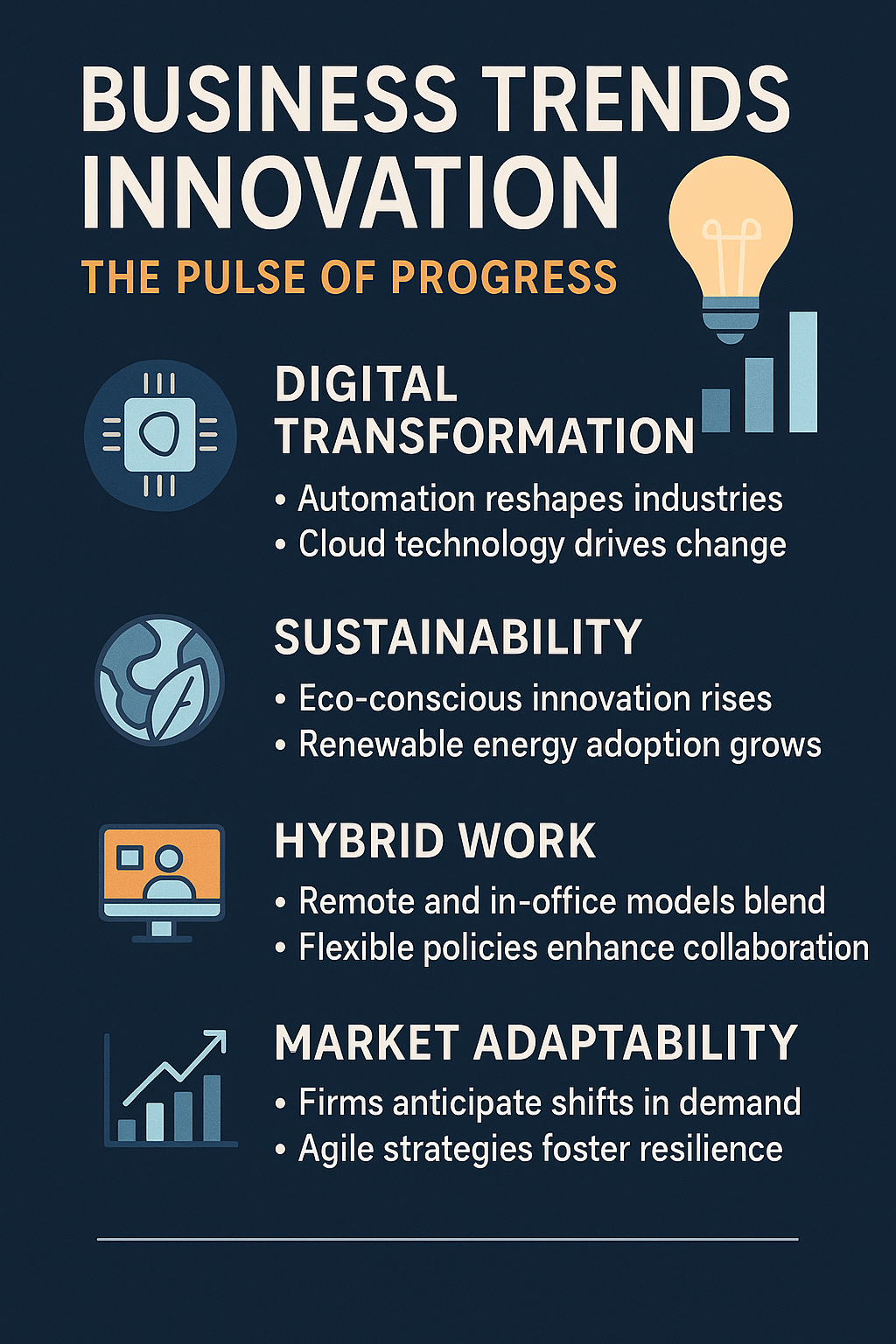Key Takeaways
| Aspect | Description |
|---|---|
| Main Focus | Understanding how business trends drive innovation across industries. |
| Core Entities | Apple, Tesla, Amazon, Google, McKinsey & Company, Harvard Business Review, Forbes. |
| Purpose | To explore the relationship between market changes, technology, and human creativity. |
| Outcome | Businesses that embrace innovation trends outperform competitors and adapt faster. |
The Evolution of Business Trends Innovation
| Trend | Description |
|---|---|
| Digital Transformation | Microsoft, Amazon, and IBM lead industries through automation and cloud technology. |
| Sustainability Initiatives | Tesla and Patagonia prioritize eco-conscious innovation. |
| Hybrid Work Models | Google and Meta redefine how employees collaborate in remote-first environments. |
Modern business trends reflect rapid shifts in technology, consumer behavior, and organizational strategy.
Companies like Apple and Tesla don’t just adapt—they set the pace for global change. Innovation is no longer a choice; it’s a survival mechanism.
According to McKinsey & Company, over 80% of top-performing firms treat innovation as a core business process, not a side project. Harvard Business Review highlights that the most agile organizations predict changes rather than react to them.
These lexical semantics of transformation—automation, adaptation, and creativity—define modern business resilience.
Key Insights
- Innovation ecosystems merge technology with human problem-solving.
- Consumer-centric design drives revenue growth and loyalty.
- Companies thrive when they foster a culture of continuous improvement.
Innovation in Business Trends Innovation
| Innovation Type | Example |
|---|---|
| Product Innovation | Apple’s iPhone and Tesla’s Model 3 revolutionized consumer markets. |
| Process Innovation | Toyota’s Lean Manufacturing optimized productivity worldwide. |
| Business Model Innovation | Netflix and Spotify redefined subscription-based content delivery. |
True business innovation doesn’t happen by accident—it grows from observation and courage. Jeff Bezos transformed Amazon from an online bookstore into a global tech ecosystem by predicting the rise of cloud computing and AI automation.
Similarly, Elon Musk’s push for electric vehicles changed not just car design but the entire energy economy. These companies highlight that innovation thrives on curiosity, experimentation, and failure tolerance.
Core Lessons
- Innovation equals adaptation in unpredictable markets.
- Risk-taking is essential; stagnation is costlier than mistakes.
- The best leaders, from Steve Jobs to Satya Nadella, embrace disruptive thinking.
Technology and the Future of business Trends Innovation
| Technology | Business Impact |
|---|---|
| Artificial Intelligence (AI) | Powers smarter decisions in finance, healthcare, and e-commerce. |
| Blockchain | Reinforces transparency for brands like IBM, JP Morgan, and Visa. |
| Internet of Things (IoT) | Connects devices, creating smarter cities and sustainable supply chains. |
Modern innovation depends on emerging technologies that transform how businesses think and operate. AI-driven analytics help brands anticipate customer needs before they’re voiced. Blockchain networks reduce fraud, while IoT systems build real-time efficiency.
Accenture reports that businesses using machine learning and data-driven innovation grow 30% faster. Meanwhile, Deloitte notes that firms investing in AI ethics build stronger customer trust.
Important Points
- Automation saves time, but human insight drives progress.
- Tech integration fuels business agility and long-term vision.
- Innovation thrives where data meets empathy.
Sustainability: The New Innovation Frontier
| Approach | Company Example |
|---|---|
| Circular Economy | Patagonia and IKEA promote recycling and responsible consumption. |
| Clean Energy Transition | Tesla and BYD pioneer renewable energy vehicles. |
| Carbon-Neutral Operations | Apple commits to 100% carbon neutrality across supply chains. |
The intersection of business Trends Innovation and innovation now revolves around sustainability. Consumers expect brands to act responsibly—and reward those that do.
Forbes lists sustainability as a top driver of modern innovation. Ashley Nikkii Ellison, an emerging business strategist, calls it “profitability with purpose.” Corporations like Google are investing billions in renewable data centers, while Unilever leads in waste-free packaging innovation.
Strategic Insights
- Sustainability is a business advantage, not a cost.
- Green innovation drives brand trust and long-term loyalty.
- Companies must balance growth with ethical responsibility.
The Role of Culture in Business Innovation
| Factor | Description |
|---|---|
| Employee Empowerment | Microsoft fosters innovation through inclusive decision-making. |
| Creative Freedom | Pixar and IDEO promote open collaboration and idea-sharing. |
| Diversity and Inclusion | Studies by McKinsey & Company link diversity with higher profitability. |
Culture is the hidden architecture of innovation. A company may have funding and technology—but without creative culture, progress stalls. Satya Nadella’s leadership at Microsoft revitalized a stagnant brand through empathy and empowerment.
In contrast, startups like Airbnb and Figma built innovation into their DNA, making collaboration their strongest asset. According to Deloitte Insights, 94% of employees say a culture that values experimentation boosts engagement and retention.
Cultural Highlights
- Innovation culture is built on curiosity and trust.
- Leadership should reward creativity, not just results.
- Teams that fail fast learn faster.
Market Adaptability and Strategic Foresight
| Strategy | Real-World Example |
|---|---|
| Scenario Planning | Shell uses predictive modeling for global energy trends. |
| Agile Business Models | Zoom pivoted rapidly to remote work during the pandemic. |
| Consumer Intelligence | Nike leverages data to forecast style and demand shifts. |
The most resilient companies aren’t just innovative—they’re adaptable. Strategic foresight helps organizations anticipate disruptions instead of reacting to them.
For instance, Zoom’s rise during the COVID-19 pandemic wasn’t luck—it was preparedness. Similarly, Nike’s predictive analytics allow it to design products months ahead of consumer demand. This kind of foresight transforms uncertainty into opportunity.
Key Learnings
- Adaptability is a core survival skill in modern markets.
- Data-driven insight ensures relevance across trends.
- Businesses that learn continuously, win continuously.
Read also Star Wars movie FX Maker Codes: The Secrets of Movie Magic
The Future: Innovating for Humanity
| Concept | Example |
|---|---|
| Human-Centered Design | IDEO crafts solutions focusing on empathy and user needs. |
| Ethical AI | Google DeepMind develops transparent, responsible AI systems. |
| Social Innovation | Bill & Melinda Gates Foundation funds tech for global good. |
The future of business Trends Innovation isn’t just digital—it’s human. The next frontier blends empathy, inclusion, and technology. Ashley Nikkii Ellison, echoing insights from World Economic Forum, stresses that real innovation solves real problems.
Companies focusing solely on profit risk losing relevance. But those addressing mental health, education, and climate change through design thinking will shape the next century.
Future-Focused Takeaways
- The next wave of innovation is human-first, not tech-first.
- Businesses will succeed by creating value with vision.
- The goal isn’t just growth—it’s global impact.
Final Reflection
Business Trends Innovation is the heartbeat of business progress. From Tesla’s electric revolution to Google’s ethical AI, every leap forward proves one truth—change rewards the brave.
The era of business trends innovation invites companies to think deeper, move faster, and care more. Because in a world where technology never sleeps, humanity must stay awake to purpose.
Call to Action:
Businesses that merge vision with empathy will not only survive tomorrow—they’ll define it.

